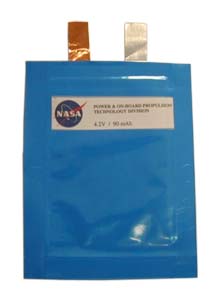 Tough and compact: Lithium-ion cells that use
polymer electrolytes can be affordably packaged in compact, flexible pouches
(shown above), instead of the laser-welded metal containers used in current
cells.
Tough and compact: Lithium-ion cells that use
polymer electrolytes can be affordably packaged in compact, flexible pouches
(shown above), instead of the laser-welded metal containers used in current
cells.
A new incarnation of lithium-ion batteries
based on solid polymers is in the works. Berkeley, CA-based startup Seeo,
Inc. says its lithium-ion cells will be safer, longer-lasting, lighter,
and cheaper than current batteries. Seeo's batteries use thin films of
polymer as the electrolyte and high-energy-density, light-weight electrodes.
Lawrence Berkeley National Laboratory is now making and testing cells designed
by the University of California, Berkeley spinoff.
Lithium-ion batteries are used in cell phones
and laptops because they are smaller and lighter than other types of batteries.
They are also promising for electric and hybrid vehicles.
However, conventional materials and chemistries
have stopped them from being used extensively in cars.
Today's lithium-ion batteries use lithium
cobalt oxide electrodes and a liquid electrolyte, typically lithium salts
dissolved in an organic solvent. The electrode material can release oxygen
when overcharged or punctured, causing the flammable solvent to catch fire
and the battery to explode. Besides, "the charged electrodes are very reactive
with the liquid electrolyte, which reduces power and [cycle-life]," says
Khalil Amine, manager of the advanced battery technology group at Argonne
National Laboratory.
Seeo's key breakthrough is a solid polymer
electrolyte. It is not flammable and hence inherently safer. In addition,
the battery will retain more of its capacity over time because the polymer
does not react with the charged electrode. "Lifetime data suggests that
conventional lithium-ion systems lose about 40% capacity in 500 cycles,"
says Mohit Singh, the cofounder of Seeo. "We get a much better cycle
life. We can go through 1,000 cycles with less than 5% capacity loss."
For the negative electrode, or anode, the
electrolyte also works with lithium metal films, which are lighter than
current anode materials. That means the battery can provide more energy
for the same weight. Based on the battery's single cell, Seeo has calculated
that it would have an energy density of up to 300 watt-hours per kilogram,
which is 50% greater than lithium-ion batteries that are on the market
today. |
Batteries with solid electrolytes have the
added bonus of being cheaper to manufacture, Amine says. While liquid electrolytes
have to be tightly sealed inside a laser-welded metal container, plastic
electrolytes can be packaged inside heat-sealed pouches.
The advantages of polymer materials have warranted
research on polymer electrolytes for more than three decades. In fact,
lithium polymer batteries are already found in radio-controlled cars and
MP3 players. But they use a polymer gel containing solvents, so, like liquid
electrolytes they carry the risks of fire or explosion and do not have
a very long life.
Making solid polymers that are as conductive
as liquid electrolytes has been difficult. In a charging battery, the electrolyte
conducts lithium ions from the positive electrode, or cathode, to the anode.
The higher the conductivity of the electrolyte, the faster the battery
charges. St. Paul, MN-based 3M and Montreal, Canada-based electricity provider
Hydro-Québec have spent more than 10 years on solid-polymer lithium
batteries. "But you have to operate the polymer at 60 degrees Celsius
to improve conductivity," Amine says. "This is not very practical."
The problem is that a polymer's conductivity
and mechanical strength do not go hand-in-hand. "If people tried to
make polymers with high ionic conductivity they would end up with a goop,"
Singh says.
Seeo has gotten around the problem by making
films with block copolymers: materials containing two linked polymer chains
that self-assemble into nanostructures. One of the polymers forms an array
of conductive cylinders that are embedded within the other polymer, which
serves as a hard matrix. Singh says the electrolyte film is robust and
is almost as conductive as liquid electrolytes.
Seeo's technology "has become very attractive"
because of its claim of a high-conductivity polymer, Amine says. However,
"the lithium anode could be a show-stopper." Lithium has a tendency
to get roughened at the surface and grow crystal dendrites that can reach
the cathode and short the battery. The company will need to do long-term
tests to show that its polymer is hard enough to block the dendrites.
Polymer electrolytes also have one big inherent
disadvantage. "Polymers will always be limited by lower ionic conductivity
compared to liquids," Singh says. This means that Seeo's battery would
be limited for use in laptops and electric vehicles. "But these polymers
wouldn't be able to address quick-charge applications like hybrid-electric
vehicles or power tools." |